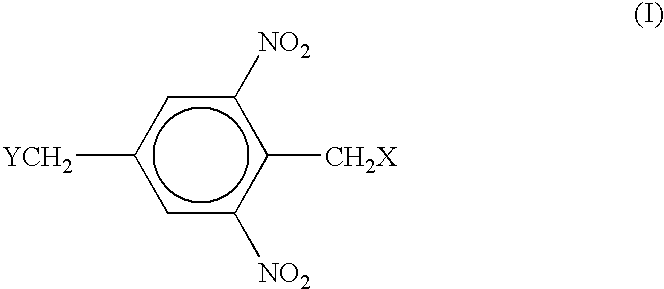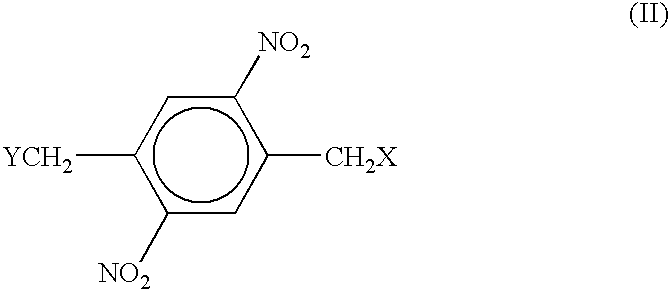Positive photoresist compositions having enhanced processing time
a technology of photoresist and composition, applied in the field of positive photoresist compositions having enhanced processing time, can solve the problems of increased energy requirements, long processing time of positive photoresists, and problems in the finished product, and achieve the effect of shortening the tim
- Summary
- Abstract
- Description
- Claims
- Application Information
AI Technical Summary
Benefits of technology
Problems solved by technology
Method used
Image
Examples
example 1
[0034] LIQUIDIMAGE PLUS, a positive photoresist commercially available from PPG Industries, Inc., was used as a control. LIQUIDIMAGE PLUS was mixed with 2-diazo-1-naphthol-4-sulfonic acid, sodium salt ("DNQ") compounds that had been dissolved in DMSO. A 1 percent DNQ solution, 3 percent DNQ solution and 6 percent DNQ solution were prepared and added, respectively, to Samples 1-3 by mixing 1.1, 3.2 or 6.2 grams, respectively, of the appropriate 30 percent DNQ / DMSO solution, which had been prepared by adding 5 grams of DNQ to 10 grams DMSO, with 100 grams of LIQUIDIMAGE PLUS (32% solution). For Sample 4, 4.1 grams of DMSO were mixed with 100 grams of the LIQUIDIMAGE PLUS (32% solution).
[0035] The control and Samples 1-4 were applied to separate sheets of copper laminate using #14 wirewound draw-down bar. After two minutes of a room temperature flash, and a six minute bake at 125.degree. C., a dry film thickness of 0.2 mil was obtained. The coated laminates were exposed to a dosage of ...
example 2
[0038] A LIQUIDIMAGE PLUS formulation was prepared as generally taught in U.S. Pat. No. 6,100,008 but without the bis-t-butyl phenylether dissolution inhibitor typically used. To this formulation was added the various additive(s) shown in Table 3. The samples were applied to copper laminate and tested in the manner generally described in Example 1. Film loss in unexposed areas after exposure to the NaOH solution for four times the clear time were also measured (4.times.UFL). A 4.times.UFL of 10 percent or lower is typically desired. Results are also shown in Table 3.
3TABLE 3 Wt % of additive Clear time Clear time Copper based on (sec) for (sec) for appearance total solid 400 mJ 200 mJ after clear Sample Additive weight exposure exposure time 4 .times. UFL (%) 5 bis-t-butyl 2 14 30 Clear 3.78 phenylether 6 2-(phenylsulfonyl).sup.1 2 12 30 Clear 5.93 acetophenone 7 2-(phenylsulfonyl) 5 10 20 Clear 6.05 acetophenone 8 2-(phenylsulfonyl) 10 9 17 Clear 11.14 acetophenone 9 monoester of 2...
example 3
[0040] Assuming that a maximum development time of 60 seconds is practical in a production environment, films of several compositions deposited onto copper substrates as described above were exposed with a 21-step Stouffer Step Tablet at different exposure dosages using a Colight 1630 Exposure Unit; following exposure, the panels were each developed for 60 seconds in a 1.5 percent NaOH solution at 105.degree. F.
4 Samples 400 mJ / cm.sup.2 300 mJ / cm.sup.2 200 mJ / cm.sup.2 150 mJ / cm.sup.2 5 3+ to 4- 3 2 0 6 4+ to 5-3+ to 4- 2+ 0 7 5- 4 3- 2 8 6 5 4 3
[0041] An SST of 3 to 5, especially 3 to 4, gives the desired resolution and artwork reproduction. Lower SST's indicate an underexposed condition. Slightly higher SST's are acceptable as long as excessive unexposed film loss does not result. Samples 6 through 7 of the present invention gave comparable, if not superior, results as compared with control Sample 5 in most cases. At lower dosages, i.e. 300 to 150 mJ / cm.sup.2, results using the pre...
PUM
| Property | Measurement | Unit |
|---|---|---|
| time | aaaaa | aaaaa |
| time | aaaaa | aaaaa |
| UFL | aaaaa | aaaaa |
Abstract
Description
Claims
Application Information
 Login to View More
Login to View More - R&D
- Intellectual Property
- Life Sciences
- Materials
- Tech Scout
- Unparalleled Data Quality
- Higher Quality Content
- 60% Fewer Hallucinations
Browse by: Latest US Patents, China's latest patents, Technical Efficacy Thesaurus, Application Domain, Technology Topic, Popular Technical Reports.
© 2025 PatSnap. All rights reserved.Legal|Privacy policy|Modern Slavery Act Transparency Statement|Sitemap|About US| Contact US: help@patsnap.com


